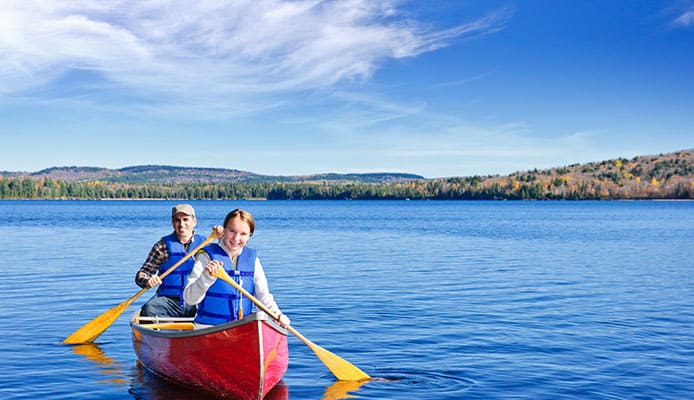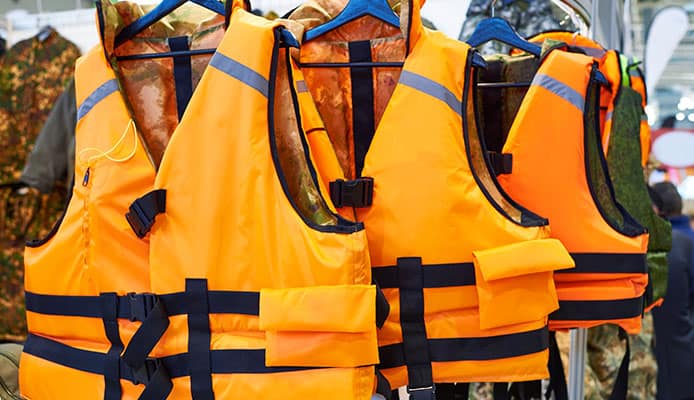
When talking about life jackets and personal flotation devices (PFD), most people think that they are the same. Although that is true in a sense, there are marked differences between a life jacket and PFD aside from the design and style. Below we outline some of these differences and why knowing them is important. We’ll also throw in some tips when it comes to buying a life jacket or PFD so you won’t feel confused and overwhelmed when you enter the sporting goods store to buy one.
Life Jackets
Life jackets are the ones that you commonly see being worn in the water and displayed in boats and other sailing vessels. They look more like vests instead of jackets and usually come in orange or red colors. They are also quite bulky since most of their buoyancy materials are in front of the jacket, which is why some people say that they are uncomfortable to wear. Life jackets also have a large collar to support the head.
Although most people know that life jackets will keep you afloat while in the water, they are not aware of perhaps the most important feature of this life-saving device. That is, the best life jackets will turn an unconscious person from a face-down position into a face-up position, thus allowing them to breathe. This is why some experts recommend using life jackets for weak swimmers and children since it provides more buoyancy and thus gives the wearer a better chance of survival.
Personal Flotation Device (PFD)
A personal flotation device or PFD is a broad term and refers to any device that aids in flotation or helps keep the wearer afloat. As such, a life jacket or a life vest is also considered to be a PFD. However, there is a huge difference between life jackets and other types of PFDs.
Remember, life jackets are designed to turn an unconscious person from a face down to a face-up position. On the other hand, other types of PFDs do not have this ability, which means that although the unconscious wearer may be afloat, his or her face may still be submerged in the water and thus prevent them from breathing. This is why most PFDs are only recommended to be worn by people engaging in sports where falling into the water (with very little to no chance of becoming unconscious) is expected such as in wake surfing, paddle boarding, and others.
At this point, it may seem like a life jacket would be the better choice of the two given its ability to turn the wearer face up in the water. However, there are several reasons why you may want to consider wearing a PFD instead of a life jacket.
- PFDs are less bulky than life jackets, which in turn makes them more comfortable to wear. One reason for this is that most PFDs have their buoyancy systems at the back instead of at the front (as is the case with life jackets).
- Most PFDs are designed in such a way that they allow for a better range of motion and freedom of movement. This then eliminates (or at least reduces) chaffing in the armpits.
- Most PFDs are designed to be worn for specific sports. There are PFDs for snorkeling, PFDs for kayaking, PFDs for paddle boarding, and so on. Because they are designed to be worn for such activities, they have certain features that you won’t find in an ordinary life jacket.
Buying a Life Jacket or PFD

Buying a life jacket or personal flotation device shouldn’t be too complicated. But if you still feel overwhelmed with the choices available to you, the following tips should help make the decision-making process much easier.
US Coast Guard Approved
Whether you’re buying a life jacket or PFD, you must buy and use only those that have been approved for public use by the US Coast Guard. In fact, there are laws regarding the use of life jackets that state that the only USCG approved life jackets are allowed for public use. This stamp of approval is a sign that the life jacket or PFD has passed the strict requirements of the government, and are thus safe and effective. You can check the USCG stamp of approval which is usually displayed in the label inside the life jacket or PFD.
You might also like: How To Clean Life Jackets?
Comfort
One of the main reasons why so many people don’t like wearing life jackets and personal flotation devices is because they can be quite uncomfortable. In the case of life jackets, there is very little you can do to make them feel comfortable given their bulky design. However, with PFDs, there are plenty of options available that can be very comfortable and doesn’t feel restrictive. In any case, you’ll want to make sure that your life jacket or PFD is comfortable since you are less likely to wear it if it isn’t.
Fit
The life jacket you get must fit you properly. For adults, life jackets and most PFDs are measured based on chest size. In the case of life jackets for children, the measurement is based on their weight. There are some PFDs that are designed specifically for women. Such PFDs usually have shorter torso lengths which prevent them from riding up. A correctly fitting life jacket or PFD should feel tight but not restrictive and should not affect your ability to draw a deep breath.
Adjustments
Try to look for life jackets or personal flotation devices that have adjustable straps on them. These straps will allow you to adjust the fit of the life jacket or PFD which can be helpful if you’re planning to use them all year round. For instance, if you’re going sailing on a hot day, you can wear minimal clothing and simply tighten the straps on the life jacket or PFD for a good fit. On the other hand, if you’re going out during cold weather, then you can loosen the straps so you can wear layers of insulated clothing underneath the life jacket or PFD.
Globo Surf Overview
The terms ‘life jacket’ and ‘personal flotation device (PFD)’ are commonly used interchangeably. This is probably why many people usually don’t bother knowing the differences between a life jacket and PFD. Regardless, a life jacket must be worn whenever you’re engaged in some form of water sport or activity, especially for children and weak swimmers. Life jacket, life vest, PFD – whatever you want to call it, remember that it only works if you wear it.

